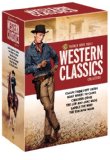| Reviews & Columns |
|
Reviews DVD TV on DVD Blu-ray 4K UHD International DVDs In Theaters Reviews by Studio Video Games Features Collector Series DVDs Easter Egg Database Interviews DVD Talk Radio Feature Articles Columns Anime Talk DVD Savant Horror DVDs The M.O.D. Squad Art House HD Talk Silent DVD
|
DVD Talk Forum |
|
|
| Resources |
|
DVD Price Search Customer Service #'s RCE Info Links |
|
Columns
|
|
|
Western Classics Collection (Escape from Fort Bravo/The Law and Jake Wade/Saddle the Wind/Cimarron/The Stalking Moon)
THE MOVIE:
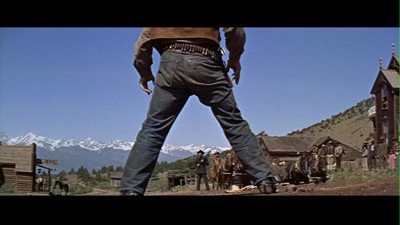
The new six-movie boxed set Warner Home Video Western Classics Collection brings together a handful of mid-list Westerns that have little in common outside of genre and a few shared directors and stars. Though the set is priced at the bargain cost of what you would have to pay for five of these movies on their own, whether it's best to buy the whole thing or pick and choose from the individual releases is likely to be a matter of personal preference. None of the movies are particularly bad, but most of them are merely average and not likely to inspired repeat viewings except from the most ardent of cowpokes.
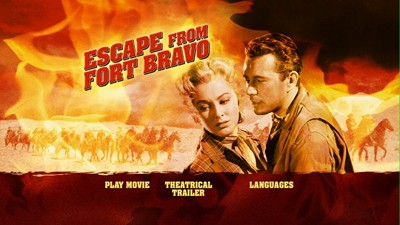
* Escape From Fort Bravo (1953, 98 minutes) - 3 stars: This William Holden vehicle is the first of a two movies in the box to be directed by John Sturges, who would go on to greater fame as the director of The Great Escape. This earlier escape has little in common with that later escape, and certainly none of the clever machinations that made it so that classic deserved the "great" in its title.
Holden plays Captain Roper, a hard-as-nails soldier in the Union Army who is second-in-command at an Arizona prison camp. Given that we first meet him as he drags an escaped Confederate POW back into Bravo tied up and pulled behind his horse, I actually thought Roper was a nickname given to him by his prisoners. Nope, that's just the nature of the on-the-nose writing from Frank Fenton (River of No Return), whose by-the-numbers script gets the job done without really bringing any depth to the situation. Four of the captured men are planning a prison break, led by Capt. Marsh (John Forsythe), a smart leader with the compassion for his men that Roper lacks. His scheme involves an old flame, Carla (Eleanor Parker), who comes to Bravo under the pretense of attending a wedding, but is really setting up the opportunity for her boyfriend to break out. Her main job is to distract Roper, but no one bargained on them falling in love for real.
The escape takes up the front half of the picture, and it moves a little slow. Roper quickly catches up with the fugitives, and the back half of Escape from Fort Bravo involves the Indian attack the group runs into on their trek back to Bravo. Pinned down in the desert, the stand-off turns into a waiting game. There is only so long that the soldiers--who are now united as one against a common foe--can hold off the enemy before the sun fries them, they run out of ammo, or they fall in the intermittent skirmishes. Surprisingly, the movie picks up here despite the action being limited to a single desolate spot. There is an inherent tension in the scenario that works well to bring the viewer in, and a conflict between Roper and the coward of the bunch (John Lupton), the man Roper already dragged back to camp once, gives the finale a depth lacking in the Bravo scenes. Holden, in one of his more manly roles, gets a pretty big end scene that effectively redeems the hard-ass jailer as a hero worthy of his lady's love.
Audio/Video: Escape from Fort Bravo is presented in a widescreen transfer preserving its original 1.75:1 aspect ratio (IMDB erroneously lists the film at 1.37:1; our own Stuart Galbraith is on the case, though, in his thorough review of this set). The picture quality is fair but inconsistent, with noticeable shifts even within scenes where the image becomes grainy or the resolution goes soft. There is also at least one scene in the Dolby Surround mix, when Roper catches up to Marsh and the two argue before they throw their punches, where the dialogue suddenly sounds distant and a tad distorted.
There are French subtitles and English Closed Captioning.
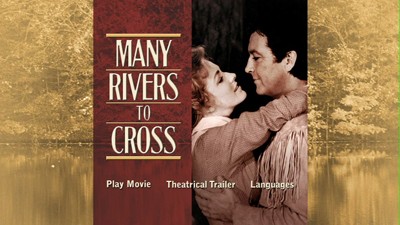
* Many Rivers to Cross (1955, 95 minutes) - 1 1/2 stars: Eleanor Parker returns for a lame frontier comedy, once again playing a gal who may be a little too big for her britches. When happy-go-lucky fur trader Bushrod Gentry (Robert Taylor) is attacked by Shawnee tribesmen, he is bailed out by Parker's Mary Stuart Cherne, and I guess the sight of a wounded man gets the girl weak in the knees, because she goes ga-ga for the fella in the coonskin cap and fringed jacket. Bushrod ain't the marrying kind, but he endears himself to the Cherne clan, including her Scottish pappy (Victor McLaglen), who presumably was the secret inspiration for the similar father played by Mike Meyers in So I Married an Axe Muderer. They love him so much, they force Bushrod to tie the knot with Mary Stuart at gunpoint. He tries to get away, but she keeps chasing him, until the table turns and he chases her back.
There is not much to recommend Many Rivers to Cross. Instead, just search YouTube for the lone funny scene, when Alan Hale Jr. (the future Skipper of "Gilligan's Island") declares his manliness, and save yourself sitting through the rest. Director Roy Rowland (Meet Me in Las Vegas) apparently has some kind of grudge against comedy, as he all but annihilates it here. The plodding direction makes the hammy plot all the more unbearable, and though Eleanor Parker is gung-ho to make something of her ridiculous role, Robert Taylor looks like he's nursing a hangover while trying to entertain a children's birthday party. The camp value of his George-Michael-in-the-Wilderness outfit and the fact that his name is Bushrod doesn't even encourage much chuckling. It's also way too early for the film to feature the Jimmy Cliff song of the same name as its theme, which would have at least allowed for a couple of minutes with something decent to listen to. Dull, dull, dull.
Audio/Video: Many Rivers to Cross was shot in Cinemascope at the very wide 2.55:1 (according, again, to IMDB). The transfer is pretty clean with only a minor amount of scratching and fairly decent resolution. The sound quality doesn't really have any problems, either.
There are French subtitles and English Closed Captioning.
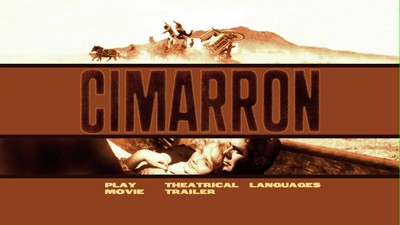
* Cimarron (1960, 147 minutes) - 3 1/2 stars: Anthony Mann helms this sprawling epic based on a novel by Edna Ferber, author of Giant. Beginning with the Oklahoma Land Rush of 1889 and traversing 25 years to end at the outset of WWI, Cimarron tracks the ups and downs of the Cravat family. Glenn Ford, in a wonderfully cerebral performance, plays two-fisted liberal Yancey Cravat, nicknamed "Cimarron." Yancey spread a lot of wild oats around in his past, but now that he is married to a good country girl, Sabra (Maria Schell), he wants to settle down and run a ranch. Things don't work out in the Rush, and instead Yancey takes over the town newspaper to follow in the footsteps of his surrogate father (Robert Keith) and stand up for the rights of the little man. His refusal to back down from a fight gets Yancey in trouble, however, and his wanderlust pulls him from home, leaving Sabra to raise their son, Cimarron Jr., on her own.
Mann seems most at home in the early part of the picture. The massive staging of the Land Rush is awe-inspiring and features several true nail-biting moments. There are also several great scenes with Yancey taking a stand, including squaring off with the town bully (Charles McGraw) and trying to set a young outlaw (Russ Tamblyn) on the straight and narrow. Some of the larger tale of family and love gets a short shrift, however. Yancey's past with the local madame, Dixie (Amme Baxter), is never really developed, and once Glenn Ford disappears from the movie, Cimarron starts to drag. Maria Schell doesn't have the acting chops to pull the film to its close, and she doesn't seem nearly as comfortable playing the take-charge older woman as she does the naïve, fish-out-of-water younger woman.
Still, as far as historical family epics go, Cimarron is a pretty solid entry in the genre. There isn't a lot of cowboy action, but the film is worth a look to see how quickly life was transformed in so short a time. The Oklahoma town goes from nonexistent to sprawling metropolis in a quarter century, and its changes can also be viewed in the changes of the various side characters, making for a rich story that mostly satisfies.
Audio/Video: At a 2.35:1 aspect ratio, Anthony Mann was able to capture the massive action of the Oklahoma Land Rush, but the DVD is a little below what the photography deserves. There are intermittent instances of surface dirt on the frame and a hazy picture; there is also frequent edge enhancement. It's not entirely horrible for an older movie, but it wouldn't fly were this a higher-end release.
There are French subtitles and English Closed Captioning.
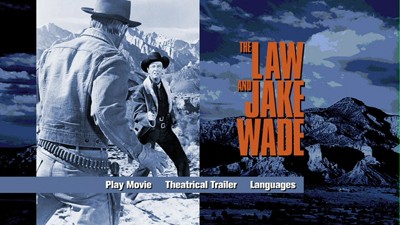
* The Law and Jake Wade (1958, 86 minutes) - 3 1/2 stars: In the second film in the Western Classics Collection to be directed by John Sturges, returning star Robert Taylor plays the titular Wade, a former bank robber turned Marshall. Jake has set up a pretty good life for himself working for the law and leaving his past in the dust. He's even engaged to be married to the town beauty (Patricia Owens). When a sense of obligation compels him to spring his old partner, Clint (Richard Widmark), from the pokey, however, the past comes catching up faster than Jake can handle. The last time Clint saw Jake, he was going in the wrong direction with $20,000 they just stole. Looking to get his loot back, Clint and the gang kidnap Jake and his fiancée and head out to the desert to find where the cash is buried. A couple of escape attempts and an Indian attack later, it comes down to two men, two guns, and the greater will to live.
The Law and Jake Wade is entertaining, though unremarkable. The appeal of the film really rests on Richard Widmark, who single-handedly gives the picture a spark of life. Taylor is good, but maybe a little too stiff, and though the lesser gang members have a couple of scenes where they can show off, they are completely eclipsed by Widmark's charisma. The actor gives Clint the proper amount of swagger. He's both charming and menacing, and the script by William Bowers (Support Your Local Sheriff) even drops hints to the man's loyalty and sense of duty--the kind of interior dichotomy Widmark portrayed better than anyone. When it's boiled down, The Law and Jake Wade is a masculine narrative about what it means to be friends and have a guy's back, and if you can make it through the turgid Indian siege, the final shoot-out is well worth the effort.
Audio/Video: Also in 2.35:1, the image quality of Jake Wade is one of the best on this set, with nice colors and very little wear and tear. I did see quite a bit of artifacting in darker scenes, though, with the indigo blue night skies and black shadows looking very patchy.
There are French subtitles and English Closed Captioning.
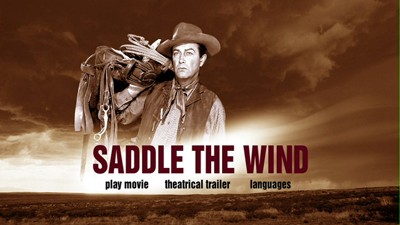
* Saddle the Wind (1958, 84 minutes) - 4 stars: Robert Taylor takes his third starring role in the box in this Rod Serling-penned tale of two brothers with different ideas about gunplay. Taylor is Steve Sinclair, a retired gunslinger looking to establish a quiet life on a small cattle ranch. His younger brother, Tony (indie legend John Cassavetes), grew up watching Steve duel with other outlaws, and he can't understand why anyone would give up the lifestyle. He has a taste for pistol action, one that turns into bloodlust after he makes his first kill (Charles McGraw). As much as Steve tries to keep Tony out of trouble, he can't stop the kid from charging forward, and Tony nearly starts a land war when a poor farmer (Royal Dano) tries to claim grazing land as his own. It comes down to brother vs. brother and a surprising ending I would have never seen coming.
As a dyed-in-the-wool Twilight Zone fan, I'll watch just about anything with Rod Serling's name on it, and his take on the western genre does not disappoint. Working from a story by Thomas Thompson, Serling does his usual fine work, creating vivid characters and maneuvering them through a complicated situation full of conflict and moral nuance. The deadly sibling rivalry has echoes in the friction between former Confederate and Union soldiers that runs through Saddle the Wind, and the central conflict encompasses questions of law and order, a man's rights on the open plain, and the consequences of a life of violence. Ironically, the start of the picture features Tony returning home from a trip to the nearest town, bringing a fiancée back with him. Joan is played by slinky chanteuse Julie London, who pulls extra duty singing the Elmer Bernstein title song. By hooking up with Joan, Tony brings Steve the final component they would need to establish a real family on the Double S Ranch, only to then systematically destroy their security like he's shooting clay pigeons in a carnival game.
Director Robert Parrish (The Purple Plain) steers Saddle the Wind with a steady hand, letting the disparate acting styles of Robert Taylor and John Cassavetes work in his favor for bringing the schism between old and young, between the contemplative and the impulsive brother, to fruition. The movie suffers occasionally when Parrish resorts to rear projection for close-ups in scenes where the main action takes place on real terrain, but the main drama is powerful enough to stifle such complaints. I would have been curious to hear a little background info on this film, though; I can't imagine the climax went down well with studio execs, and since IMDB suggests John Sturges and Daniel Fuchs (Criss Cross) contributed extra direction and writing without credit, there may be a behind-the-scenes story worth exploring.
Audio/Video: I have little complaints about the 2.35:1 transfer on Saddle the Wind. Both image and sound are very clear, with nicely rendered colors and almost no surface wear on the picture. It's a well-done DVD.
There are French subtitles and English Closed Captioning.
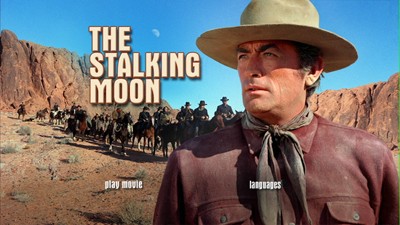
* The Stalking Moon (1968, 109 minutes) - 4 stars: Six years after they made the American classic To Kill a Mockingbird, director Robert Mulligan, producer Alan J. Pakula, and star Gregory Peck reteamed for this little known Western that is very deserving of rediscovery now that it's out on DVD. Peck plays Sam Varner, an experienced frontiersman who is ready to leave the army and retire on a little ranch he bought in New Mexico, a move he has been postponing for eight years out of a sense of duty to his fellow soldiers. On the day before his departure, his patrol runs across a stranded group of Native American women, and among them is a Caucasian, Sarah Carver (Eva Marie Saint), who was kidnapped a decade prior. Sarah is relieved to be rescued from bondage, but she is fearful for her life and the life of her son and wants to get as far away from where she was found as fast as she can.
As it turns out, Sarah's captor and the child's father is one of the deadliest Indian assassins on the plains, and though Sam originally only agrees to take Sarah to the train station and send her back to her old home back East, when he finds out the truth, his sense of honor and his sympathy for the poor woman's plight get the better of him, and he invites the wayward pair back to his ranch. Of course, danger follows, and Sam will have to defend his new home and family when the killer arrives at his doorstep.
Unsurprisingly given the team involved, The Stalking Moon is a thoughtful action picture filled with compelling story wrinkles and deep shades of character. Peck gives his usual intelligent performance as the man who knows that the right thing to do isn't always going to be what he wants to do, but that doesn't make it any less right. Mulligan makes the most of the New Mexico scenery (though he shot in Nevada), using the mountains as a natural maze for the chase scenes. There is also a tenderness to how the film treats Sarah, and Eva Marie Saint has a good handle on both the vulnerability of a victim and the fierce determination of a mother. It's a role written with very little dialogue, but she is a strong presence in the film regardless.
One note of trivia: Robert Forster fans might be curious to see the Jackie Brown actor playing Gregory Peck's Native American protégé, nearly unrecognizable in tan make-up and speaking in a heavy accent. I suppose it's to his acting credit that I wouldn't even have known it was him had I not seen his name in the credits.
Audio/Video: Yet another of the better transfers, with a solid, realistic look befitting the mostly outdoor production. The night scenes have a shimmery surface with the blacks being more faint than they should be, but that's the only real hiccup. Though most of the mono mixes on these discs are decent enough, I did particularly notice how nice the music and sound effects came across in The Stalking Moon.
Just like with the other five discs, there are French subtitles and English Closed Captioning.
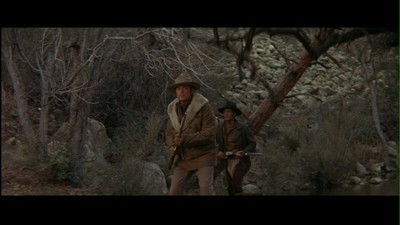
Average Score for the Films: 3 stars
Out of six movies, there are only two really essential purchases here, one absolute clunker, and three that I could either take or leave. I suppose that would mean there are more hits than misses in the box, but even so, without any unifying element to make this an essential collection where all the pieces contribute to a whole, you might want to consider cherry picking its contents and going for the individual releases.
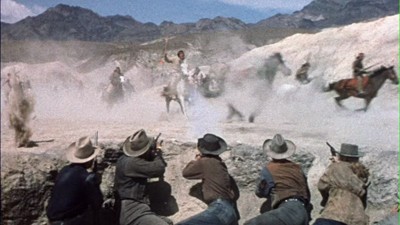
THE DVD
Please see the individual disc reviews for information about the technical quality of each DVD.
Extras:
Each movie is housed in a standard-sized DVD case, and they come packaged in a fairly sturdy outer box. The only supplements on the actual discs are a theatrical trailer for the film featured, and these appear on all of them except for The Stalking Moon, which has nothing.
FINAL THOUGHTS:
The Warner Home Video Western Classics Collection seems to be a boxed set of convenience more than it is a purposeful bundling of similarly themed motion pictures. Though the price for the set is slightly lower than the cost of buying all six movies on their own, the chances of you wanting even five of these, much less all six, is probably questionable. Many Rivers to Cross is to be avoided altogether, while the William Holden-actioner Escape from Fort Bravo, the Anthony Mann epic Cimarron, and The Law and Jake Wade, which features Richard Widmark's trademark villainy, are probably ones you really only want to sample once. That leaves Saddle the Wind and The Stalking Moon as the only two must-sees, a mere third of the overall set. By my count, that makes the Warner Home Video Western Classics Collection better to sample rather than buy. Rent It.
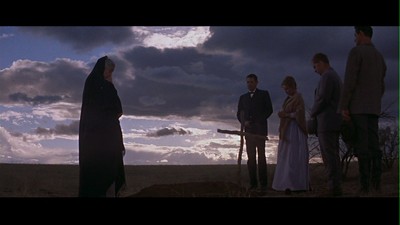
Jamie S. Rich is a novelist and comic book writer. He is best known for his collaborations with Joelle Jones, including the hardboiled crime comic book You Have Killed Me, the challenging romance 12 Reasons Why I Love Her, and the 2007 prose novel Have You Seen the Horizon Lately?, for which Jones did the cover. All three were published by Oni Press. His most recent projects include the futuristic romance A Boy and a Girl with Natalie Nourigat; Archer Coe and the Thousand Natural Shocks, a loopy crime tale drawn by Dan Christensen; and the horror miniseries Madame Frankenstein, a collaboration with Megan Levens. Follow Rich's blog at Confessions123.com.
|
| Popular Reviews |
| Sponsored Links |
|
|
| Sponsored Links |
|
|
| Release List | Reviews | Shop | Newsletter | Forum | DVD Giveaways | Blu-Ray | Advertise |
|
Copyright 2024 DVDTalk.com All Rights Reserved. Legal Info, Privacy Policy, Terms of Use,
Manage Preferences,
Your Privacy Choices | |||||||









